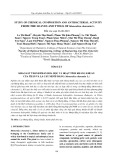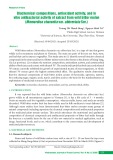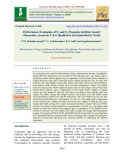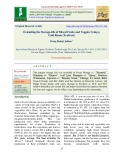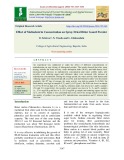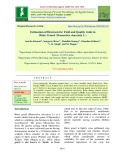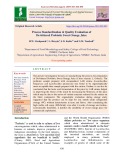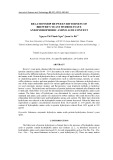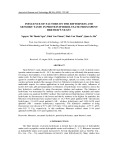
Bitter acids
-
Momordica charantia L. (bitter melon) is a plant belonging to the Cucurbitaceae family and is widely distributed in tropical and subtropical areas around the world. The aim of this study is to find out the antibacterial activity of the bitter melon (Momordica charantia L.) and investigate the chemical components of this plant.
 7p
7p  viellison
viellison
 28-03-2024
28-03-2024
 3
3
 1
1
 Download
Download
-
In this study, the total phenolic contents and total antioxidant capacities of some commercial bitter melon products (powder, packaged powder, capsule, paste in olive oil), and of unripe and ripe fruits were determined by spectrophotometric and chromatographic methods. The total antioxidant capacities of unripe and ripe bitter melon samples, determined by using the CUPRAC (cupric reducing antioxidant capacity assay) and ABTS (2,2′-azino-bis(3-ethylbenzthiazolin-6-sulfonic acid))/HRP (horseradish peroxidase) methods, were 42.5 and 36.3 µmol TRE (Trolox equivalent) g–1, and 8.7 and 7.
 11p
11p  tudichquannguyet
tudichquannguyet
 29-11-2021
29-11-2021
 8
8
 1
1
 Download
Download
-
n the present work, a pioneering attempt has been made to overexpress master regulator binary transcription factor complex formed by HlWRKY1 and HlWDR1 using a plant expression vector to enhance the level of prenylflavonoid and bitter acid content in the hop. Subsequently, we performed transcriptional profiling using high-throughput RNA-Seq technology in leaves of resultant transformants and wild-type hop to gain in-depth information about the genome-wide functional changes induced by HlWRKY1 and HlWDR1 overexpression.
 18p
18p  vitzuyu2711
vitzuyu2711
 29-09-2021
29-09-2021
 6
6
 1
1
 Download
Download
-
The main use parts of the tree are fruit, stem, and leaf that can be eaten as vegetables. This study aims to (1) identify several bioactive chemical compounds in the stems and leaves of bitter melon trees in the forests in the district of Mang Yang, Gia Lai province; (2) evaluate the nutrient composition, antioxidant activity, and antimicrobial ability of fresh juice and extract with ethanol 70°.
 6p
6p  chauchaungayxua12
chauchaungayxua12
 11-07-2021
11-07-2021
 9
9
 1
1
 Download
Download
-
An experiment was carried in Horticultural College and Research Institute, Periyakulam, during 2017.The observation were recorded on the following traits, vine length, node at which first female flower appears, days to appearance of first female flower, number of female flowers per vine, days to first fruit harvest, number of fruits per vine, sex ratio, fruit yield per vine, fruit length, average fruit weight, fruit width, fruit cavity, flesh thickness, total soluble solids, protein, ascorbic acid, iron and momordicine content.
 7p
7p  nguaconbaynhay6
nguaconbaynhay6
 23-06-2020
23-06-2020
 13
13
 0
0
 Download
Download
-
The longest storage life was recorded in Sweet Orange cv. “Mosambi”, Mandarin cv. “Kinnow”, Acid Lime, Pineapple cv. “Queen”, Beetroot, Watermelon, Capsicum cv. “Bombay Green”, Cabbage, Ivy Gourd, Bitter Gourd (Green) and Hot chilli, and the shortest in Broccoli, Lettuce and Ridge Gourd inside cold room. Storage at Ecofrost at 10°C and 93% relative humidity can extend life and improve post-harvest quality retention for fruit and veggies, but its effects vary depending on the commodity.
 5p
5p  angicungduoc5
angicungduoc5
 14-06-2020
14-06-2020
 14
14
 0
0
 Download
Download
-
An experiment was conducted to study the effect of different concentrations of maltodextrine on spry drying of bittergourd powder. The results showed that after spray drying, initially the water activity, water absorption index (WAI), and bulk density were decreased with increase in maltodextrin concentration and water soluble index, pH, ascorbic acid, reducing sugars and whiteness index were increased with increase in maltodextrin concentration.
 8p
8p  kequaidan4
kequaidan4
 05-05-2020
05-05-2020
 8
8
 1
1
 Download
Download
-
Seven genetically dissimilar parental lines i.e., Pusa Ausadhi, Jhalri, Kathi No.1, Pusa Rasdar, BRBT Local, Konkan Tara, Solan Hara were crossed in a diallel (half) pattern to get 21 hybrid to investigate extent of heterosis fruit yield and quality traits in bitter gourd at vegetable research farm, Bihar agricultural university, Bihar during summer season 2016 and 2017. The cross combination Pusa Ausadhi X BRBT Local exhibited maximum heterosis over standard check for yield and yield attributing trait like number of primary branch, vine length, fruit length and fruit weight.
 10p
10p  chauchaungayxua4
chauchaungayxua4
 18-03-2020
18-03-2020
 12
12
 0
0
 Download
Download
-
The present experiment was formulated on vegetable research farm, Bihar Agricultural University, Sabour to study the per se performance of 21 hybrids with seven dissimilar parents. The ANOVA for experimental design expressed that the treatment variance were highly significant for all the quantitative and qualitative traits. Fruit yield is the ultimate character which shows the utility of a genotype in farmer’s field. As per the present findings, the parents Pusa Ausadhi, followed by BRBT Local and Kathi No.1 were the most promising parental line.
 9p
9p  trinhthamhodang3
trinhthamhodang3
 17-02-2020
17-02-2020
 15
15
 0
0
 Download
Download
-
The present investigation focuses on standardizing the process for preparation of De-bittered Probiotic Sweet Orange Juice (Citrus sinensis L. Osbeck). The probiotic sample prepared with encapsulated LAB strains (Lactobacillus bulgaricus and Lactobacillus plantarum) was found to be organoleptically more acceptable than sample prepared with free strains.
 15p
15p  quenchua2
quenchua2
 18-12-2019
18-12-2019
 14
14
 0
0
 Download
Download
-
Hops (Humulus lupulus L. Cannabaceae) is an economically important crop, that has drawn more attention in recent years due to its potential pharmaceutical applications. Bitter acids (prenylated polyketides) and prenylflavonoids are the primary phytochemical components that account for hops resins medicinal value. We have previously reported on utilizing untargeted NMR and MS metabolomics for analysis of 13 hops cultivars, revealing for differences in a- versus b-bitter acids composition in derived resins.
 5p
5p  kethamoi1
kethamoi1
 17-11-2019
17-11-2019
 19
19
 1
1
 Download
Download
-
In this study, we used enzymatic mixture alcalase and flavourzyme, yeast treatment methods to hydrolyse brewer’s yeast. The hydrolysate and fractions of protein hydrolysate obtained after filtration with 10 kDa and 3 kDa filters were used for determination of bitterness and hydrophobic amino acids content. The bitter taste of hydrolysate was determined by sensory method (using quinine standard) and amino acid content was analysed by HPLC method.
 7p
7p  cumeo3000
cumeo3000
 01-08-2018
01-08-2018
 58
58
 3
3
 Download
Download
-
Spent brewer’s yeast, obtained after the main fermentation stage, is a rich- in-protein source (protein content accounts for 48 - 50 % dry matter). In order to use efficiently this protein source for using in food industry, it was hydrolysed by different methods into mixtures of peptides and amino acids. So that it has a wide range of applications in food.
 9p
9p  cumeo3000
cumeo3000
 01-08-2018
01-08-2018
 59
59
 2
2
 Download
Download
-
Approach to the Patient: Disorders of the Sense of Taste Patients who complain of loss of taste should be evaluated for both gustatory and olfactory function. Clinical assessment of taste is not as well developed or standardized as that of smell. The first step is to perform suprathreshold whole-mouth taste testing for quality, intensity, and pleasantness perception of four taste qualities: sweet, salty, sour, and bitter. Most commonly used reagents for taste testing are sucrose, citric acid or hydrochloric acid, caffeine or quinine (sulfate or hydrochloride), and sodium chloride.
 5p
5p  ongxaemnumber1
ongxaemnumber1
 29-11-2010
29-11-2010
 73
73
 3
3
 Download
Download
CHỦ ĐỀ BẠN MUỐN TÌM








